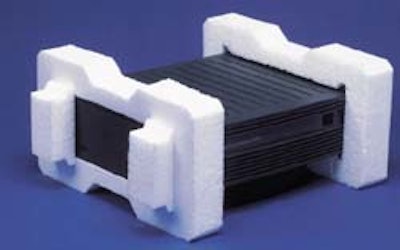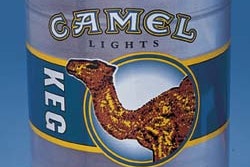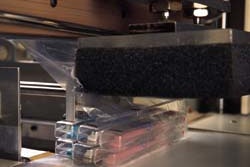They say that necessity is the mother of invention, and about a year ago, Germantown, MD-based Hughes Network Systems became a believer.
Hughes learned that the material used by converter Packaging Strategies (Baltimore, MD) to create end caps for packaging and protecting Hughes’ sensitive satellite equipment was no longer available. Forced to investigate other options, the two companies worked together to design a stronger, seamless end cap made of Kaneka Texas’ (Houston, TX) Eperan® 1 ½-lb linear low-density polyethylene foam. The new end caps not only provided better protection for Hughes’ product, but also greatly reduced storage space and transit costs for the caps, thanks to a living hinge that allows them to remain flat until used.
Previously, Packaging Strategies was creating end caps for Hughes by laminating several ½” thick layers of extruded PE together. The two pieces that extended off each cap to buffer the sides of the equipment from its corrugated shipper were positioned in place as well.
When a dispute over a patent rendered the former material unavailable, Hughes and Packaging Strategies had intended to find another supplier of laminated PE for the end caps, but they changed their minds when they learned about Eperan PE 1.5. Eperan isn’t laminated, but instead employs a very thick skin on one side that allows it to be “kiss cut”, creating a living hinge. During the kiss cut, the material is die-cut almost completely through, stopping at the skin. The die-cut portions can later be folded out to allow the satellite equipment to be inserted. Hughes’ new end cap design incorporates these one-step, flexible hinges that can be easily activated by workers on Hughes’ manual packaging line.
Successful hinge
Because the old caps were awkwardly shaped, with the buffer pieces rigidly in place they didn’t stack neatly and occupied twice as much space as the new caps. That meant more pallet loads had to be shipped to keep up with Hughes’ demand, and once the shipments arrived, they occupied too much space. Hughes was losing money, says Hughes packaging engineer Tom Alt. “With Eperan molded foam, Packaging Strategies can deliver the end caps flat with the hinge folded down, allowing more parts per pallet,” he says. “The material allows us to meet our performance criteria [such as drop-test performance, agility and value], with lower transit costs and using less storage space.”
At Hughes’ manufacturing facility, pallets of the Eperan end caps arrive on a just-in-time basis and are moved out onto the production floor in stages. “The living hinge mechanism allows us to store a tremendous number of end caps in the production zone,” Alt explains.
After the satellite equipment is assembled on the production line, it is brought downstream to a worker who removes two end caps from the pallet, opens the living hinges and places one cap on each side of the bagged satellite unit. “The caps are universal,” says Alt. “There is no left or right—that’s a wonderful feature.”
Once capped, the satellite unit is placed into a corrugated shipper and sent through a case taper. Workers manually load 42 shippers on each pallet, which are stored or shipped to industries around the world. The satellite equipment is used to send and receive multimedia data.
The living hinge also made manufacturing the end caps much easier, according to Packaging Strategies president Joe Grigg. With the old systems, a shape would have to be die-cut from the middle of the flat, laminated PE piece, then the two “rails” would have to be assembled and laminated to the flat piece. “That was expensive,” Grigg says. “Not the materials, but the labor.”
Additional benefits
In addition to saving space and shipping costs, the Eperan end caps also provide better protection for the sensitive satellite equipment. “The molded foam is more shock-absorbing than either 2.2- or 1.7-lb density extruded foam material, and it doesn’t tear apart,” says Grigg. “During drop tests, Eperan transmitted 15 to 20 percent less energy to the satellite equipment than the original material.”
Alt also points out that the material doesn’t shrink and provides better creep resistance than the extruded PE material. “When you put the package in the carton, you want the edges of the foam to be in contact with as much surface area on the sides of the carton as possible,” he explains. If the foam settles under the weight of the equipment, it reduces the number of contact points and provides gaps between foam and shipper—all of which could prove damaging to the equipment inside. That doesn’t happen with the Eperan material, he says.
Although Hughes’ customers—a group of professional installers—rarely provide positive feedback, Alt says the company “adheres to a ‘no news is good news’ theory.” Since the switch to Eperan, Alt hasn’t heard much news, which is just fine with him.
























